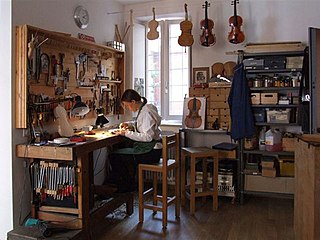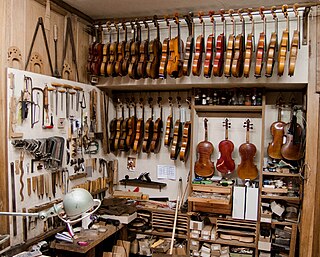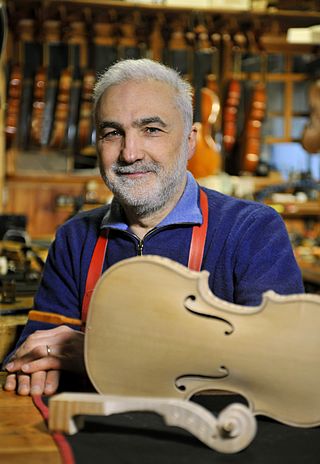Related Research Articles

A luthier is a craftsperson who builds or repairs string instruments that have a neck and a sound box. The word luthier is originally French and comes from the French word for "lute". The term was originally used for makers of lutes, but it came to be used in French for makers of most bowed and plucked stringed instruments such as members of the violin family and guitars. Luthiers, however, do not make harps or pianos; these require different skills and construction methods because their strings are secured to a frame.

Making an instrument of the violin family, also called lutherie, may be done in different ways, many of which have changed very little in nearly 500 years since the first violins were made. Some violins, called "bench-made" instruments, are made by a single individual, either a master maker or an advanced amateur, working alone. Several people may participate in the making of a "shop-made" instrument, working under the supervision of a master. This was the preferred method of old violin makers who always put their names on violins crafted by their apprentices. Various levels of "trade violin" exist, often mass-produced by workers who each focus on a small part of the overall job, with or without the aid of machinery.
Sesto Rocchi (1909–1991) was a violin maker from Reggio Emilia, Italy.

Roberto Regazzi is a notable contemporary violin maker and scholar who received his initiation in the craft from Otello Bignami. Regazzi lives and works in Bologna.

Otello Bignami was an Italian violin maker from Bologna.

Carlo Bisiach (1892–1968) was a violin maker born in Milan Italy. Bisiach's work contributed to the rebirth of violin making in the region after the difficult times of World War I and World War II. After working with his father Leandro in Milan and then Siena, Carlo established himself at Florence in 1922. The most talented of Leandro's sons, Carlo went on to develop his own style quite separate from the Antoniazzi-derived work of his father and brothers.

Giuseppe Fiorini (1861–1934) was an Italian luthier and is considered one of the most important Italian violin makers. He built his first instrument at the age of 16 while working in Bologna. He established Rieger and Fiorini in Germany from 1888, then lived in Zurich during World War 1 and Rome from 1923.

Gaetano Pollastri (1886–1960) was a professional violinist but after the first world war he devoted himself to violin making. He worked with the same company as his brother in via Castiglione, that was devoted to the construction, repair and commerce of string instruments. In 1927 he received the Certificate of Honour at the contemporary violin making exhibition-competition in Cremona. When Augusto died in 1927, he took over his brother's company. In the following twenty years Gaetano constructed numerous instruments of which, in 1930, a violin with papal coat of arms that he personally donated to Pope Pious XI. He also restored precious violins; among them, a Stradivari and a Guarneri of Guglielmo Marconi brother's property, Alfonso. He won the Certificate of Honour in Cremona in 1949. In 1954 he showed two violins at the 2nd National Competition of Contemporary violin making in Rome, obtaining a Certificate of Honour, and was present with his instruments at the Ascoli Piceno ('54) and Pegli ('56) competitions. He worked very hard to promote his profession and was a founding associate of the ANLAI. His students include Cesare Pollastri, Franco Albanelli and Otello Bignami.

Ansaldo Poggi was born in Villafontana di Medicina (Bologna), 9 June 1893 and died in Bologna, 4 September 1984. He demonstrated his talent for the making of stringed instruments at a young age. His father, also an artisan, musician and amateur violinmaker, encouraged his son, steering him toward the arts. After the end of World War I he dedicated himself to the profession, taking up the craft again alongside his father while at the same time graduating from the Philharmonic Academy of Bologna. In 1921 he met up with the famous luthier Giuseppe Fiorini, of whom he was an adored disciple. In 1923 he won his first silver medal with a viola at the National Competition in Rome.
Riccardo Antoniazzi was an Italian violin maker, the brother of Romeo Antoniazzi.

Romeo Antoniazzi was an Italian violin maker. He was the eighth son and pupil of Gaetano Antoniazzi. Antoniazzi was born in Cremona. Initially he worked with his father and brother and like them made instruments for Leandro Bisiach. However, depending on need or opportunity he worked in many different places. He worked on his own, with his brother, for Bisiach, for Monzino, or in Barlassina’s shop.

Giuseppe Pedrazzini was an Italian violin maker. He was a pupil of Riccardo Antoniazzi and Romeo Antoniazzi in Milan, then began to work on his own there. He quickly gained recognition and won awards at various exhibitions, including those in Rome in 1920 and in Cremona in 1937. He modelled his instruments after various patterns, especially those of Stradivari, G.B. Guadagnini and Amati, all of which he interpreted freely. Tonally his work is among the best of the early 20th-century Italian makers. He was a meticulous and elegant craftsman; the scrolls of his instruments are always deeply carved, and the symmetrically rounded curves of the bouts and flanks provide a distinctive touch. Besides new instruments, he made a number of skilful antiqued copies. He used a variety of different labels and, depending on the period, one of three different brands. A good part of his output was exported, and he had particularly close ties with Hawkes & Son in London. Among his pupils and associates were Ferdinando Garimberti, P. Parravicini and his nephew N. Novelli.

Raffaele Fiorini, was an influential Italian violin maker.

Garimberti, Ferdinando (6 January 1894 – 26 March 1982) was an Italian violin maker.

Giuseppe Ornati -.
Giuseppe Bernardo Lecchi was an Italian violin maker.

Augusto Pollastri was an Italian violin maker, older brother to Gaetano Pollastri. Started his career as an apprentice in Raffaele Fiorini's studio. Augusto's father was a miller and an amateur musician. Augusto was exposed to music early on, he also enjoyed visiting the shop of a famous violin maker Raffaele Fiorini, where he started to perform small services in the shop, which led to an apprenticeship with maestro Fiorini.

Tullio Bassi is an Italian violin maker. He made instruments for members of a number of renowned orchestras. He studies and follows the techniques of the renowned luthier, Antonio Stradivari.

Giacomo Bisiach was an Italian luthier.
Luciano Sderci was an Italian violin maker.
References
- ↑ MusiCanada Canadian Music Council - 1981 - Nos 45/55 - Page 46 "In 1979 Sylvio de Lellis inaugurated the first school of stringed instrument ... The school is subsidized by the Quebec Ministry of Cultural Affairs and ensures a certain continuity in an age-old ..." reprinted Journal of the Violin Society of America -Violin Society of America - 1984 Volume 7 - Page 76
- ↑ The Canadian encyclopedia (French) Lutherie "La présence d'un violon à Québec est documentée dès 1645 alors que ... Sylvio de Lellis vint au Canada en 1964 et résida à Québec de 1971 à 1980; en 1979," English Page 1419 James H. Marsh - 1988 The making of violins has flourished periodically, and the artistic traditions of the 19th-century Quebec violin-making ... have recommenced with the opening in "
- ↑ Simona Boni Romolo Ferrari e la chitarra in Italia nella prima metà del Novecento 2009 Page 291 "Concorso Internazionale di Liuteria bandito a Cremona nel 1949... medaglia d'oro; primo classificato risultò Silvio De Lellis di Roma, altri premi ...
- ↑ Kemp, Walter (2002). Musical Instruments. Canadian Encyclopedia. Archived from the original on 2016-04-10 – via HighBeam Research. String Instrument Making - The Canadian Encyclopedia "Mario Lamarre, violin maker, b Notre-Dame-des-Laurentides, Que, 21 Feb 1956, studied wood sculpture before turning to violin making with Sylvio de Lellis, and.. "
- ↑ Carlo Vettori Arte Liutaria - Numéros 2 à 15 - Page 111 "Se proprio vogliamo andare a fondo, c'è sotto tutto ciò un grosso problema di base e cioè che lo studio della liuteria, grazie ... anche sociologica, di un fenomeno dai tanti risvolti, come saggiamente consiglia anche il Maestro Silvio De Lellis."
- ↑ Noi donne Unione donne italiane - 1988 - Page 63 "La liuteria ha un'antica tradizione nel Lazio. ... Il nuovo corso di studi dura tre anni, è diretto dal maestro Silvio de Lellis, il "protettore» dei violini di Toscanini, oggi di quelli di Salvatore Accardo e Uto Ughi, e comprende molte materie: musica, ..."
- ↑ Riccardo Malavasi, Liutaio a Cremona Archived 2013-04-13 at archive.today "Tirocinio nella bottega del liutaio Riccardo Bergonzi. Ha frequentato dal 1989 al 1991 la scuola di liuteria a Roma sovvenzionata dalla regione Lazio e la comunità europea sotto l’insegnamento del maestro liutaio Silvio de Lellis."